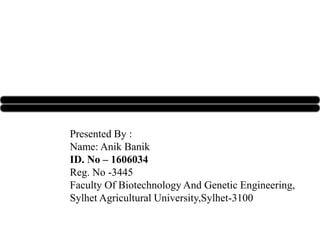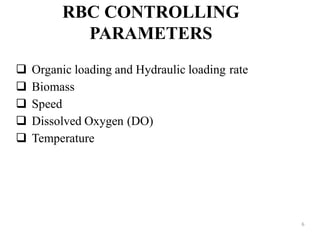Rotating biological contactor
- 1. Rotating Biological Contactor(RBC) Presented By : Name: Anik Banik ID. No – 1606034 Reg. No -3445 Faculty Of Biotechnology And Genetic Engineering, Sylhet Agricultural University,Sylhet-3100
- 2. • RBC is a fixed film, aerobic, biological wastewater treatment system. • The primary function of these bio-reactors is the reduction organic matter. Figure : A Rotating Biological Contactor WHAT is RBC
- 3. COMPONENTS Figure : Components Of RBC
- 4. OBJECTIVES The principle objective of industrial wastewater treatment is generally to allow industrial effluents to be disposed of without danger to human health or unacceptable damage to the natural environment. To manage water discharged from homes, businesses and industries to reduce the threat of water pollution .
- 5. Pretreatment Primary Treatment Rotating Biological Contactors Secondary ClarifiersSolids Handling Disinfection RBC FLOW SCHEME 5 Influent Effluent
- 6. RBC CONTROLLING PARAMETERS 6 Organic loading and Hydraulic loading rate Biomass Speed Dissolved Oxygen (DO) Temperature
- 7. SOME FACTS ABOUT DESIGNING RBC Key considerations: Mass transfer of oxygen and substrate to the microorganisms growing on the discs. Overall mass of microorganisms in the system in relation to the BOD, ammonia, and nitrogen. First stage limited by oxygen transfer, organic loading must be limited. The overall RBC surface area is then dependent on the effluent results required. Determined using 2 dimensional mass transfer models More stages may be required for nitrification (ammonia to nitrate). Submerged discs are used to achieve denitrification (nitrate to nitrogen gas).
- 8. APPLICABILITY High removal of biodegradable organic pollutants Domestic black or greywater High strength industrial waste water (dairies,paper mills,food industry,textile,pulp) Sewage water
- 9. formation Low space requirement ADVANTAGES Low energy requirements Well drainable excess sludge Simple operation Minimum maintenance Reliable liquid/solids separation No risk of channelingLow sludge production
- 10. formation Limited experience and training DISADVANTAGES Sensitivity to industrial wastes Endless electricity needed Lack of flexibility Not all materials are locally available High operation cost Odour problem may occur Must be protected environmental factors
- 11. CONCLUSION The principle objective of wastewater treatment is generally to allow human and industrial effluents to be disposed of without danger to human health or unacceptable damage to the natural environment .the RBC process is most acceptable wastewater process because of it’s benefits.
- 12. THANK YOU












